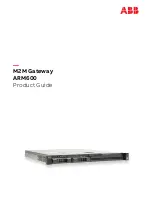
WI-GTWY-9-xxx Wireless Gateway V1.18
82
Several different configurable
transfer modes
are also available for fieldbus mappings to ensure
the I/O is formatted according to the requirements of the particular fieldbus protocol or host
device. The six possible types of Fieldbus Mapping are outlined in the table below.
Fieldbus Mapping Types
Transfer Mode Read Mapping
Write Mapping
Single Bit
The WI-GTWY-9-xxx reads a block
of consecutive bits from Fieldbus
OUT Area and stores each bit in
consecutive I/O Registers, as hex
FFFF or 0000.
The WI-GTWY-9-xxx takes the
MSB (most significant bit) of a
block of consecutive I/O Registers,
converting the 16 bit I/O register
values into 0 or 1, and writes to
consecutive bits of Fieldbus IN
Area.
Byte (8-bit)
The WI-GTWY-9-xxx reads
consecutive bytes (8-bit values)
from Fieldbus OUT Area and stores
each byte in the most significant 8-
bits of a consecutive I/O register.
The WI-GTWY-9-xxx takes the
most significant 8-bits of
consecutive I/O registers and writes
them to consecutive bytes (8-bit
values) of the Fieldbus IN area.
Word (16-bit)
The WI-GTWY-9-xxx reads
consecutive words (2x8-bit values)
form Fieldbus OUT Area and stores
each word in a consecutive I/O
Register.
The WI-GTWY-9-xxx takes
consecutive I/O registers and writes
them to consecutive words (2x8-bit
values) of Fieldbus IN Area.
4.9.2
Transfer Mode
Radio Interface registers are all 16-bit general-purpose input or output registers. That is, analog
inputs or outputs are stored as a 16-bit value. Digital inputs or outputs occupy a whole 16-bit
register and are stored as either 0000(hex) or FFFF(hex) for compatibility with the Radio
Protocol. However, the Fieldbus Interface may contain (depending on the protocol) significantly
less registers than the Radio Interface (see diagram above). Also, certain protocols may require a
different I/O structure than that used by the Radio Interface registers. Consequently, depending
on the fieldbus mapping transfer mode (see above table), Radio Interface registers may or may
not be compressed.
“Word” transfer mode offers no compression, but rather a direct transfer of 16-bit registers
between Radio Interface and Fieldbus Interface. This mode would suit the transfer of registers
containing pulse counts or analog values with no loss of resolution.
“Byte” transfer mode operates on only the most significant BYTE (the first 8 bits) of Radio
Interface registers, but allows these bytes to be consecutively packed in the Fieldbus Interface.
This mode would suit the transfer of analog values in low-resolution, in cases where I/O space is
at a premium. Byte
Address Mode
is recommended when using byte transfer mode (see Address
Mode section below).
Bit transfer mode operates on only the most significant BIT of Radio Interface registers, but
allows these bits to be consecutively packed in the Fieldbus Interface. This mode would suit the
















































